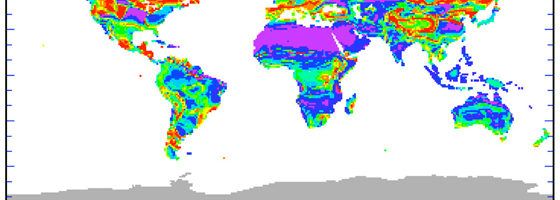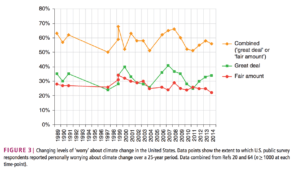The National Wildlife Federation: Preventing Tomorrow’s Water World

While the physical devastations of climate change will significantly harm the environment, the resulting behavioral and regulatory adaptations present substantial opportunities.
The National Wildlife Federation
The National Wildlife Federation is a non-profit organization dedicated to (A) The preservation of wildlife, (B) The Protection of the ecosystem and species’ habitats, and (C) The cultivation and development of future conservationists. Each of these goals will be negatively impacted by climate change’s physical consequences –as well as the provided substantial opportunity from the likely resulting regulatory and behavioral adaptations thereof.
(A) The preservation of wildlife
The preservation of wildlife and a diversity of species will likely increase in complexity and difficulty many fold over the coming years due to the burdens brought on by climate change’s physical manifestations. Numerous studies emphasize that wildlife extinction is set to rise significantly during this century. For example, many species of frogs – considered to be extinction-prone groups – are expected to reduce in population from between 39-96% over the coming 100 years [1]. In particular, studies aggregating individual hypotheses such as the above show that leading scientists, on average, believe that up to 17% of species may go extinct this century, with species of Australia, New Zealand and South America the most impacted [2]. In general, this significant increase in endangered species will put significant strain on The National Wildlife Federation’s operations – overburdening increasingly and likely at an exponential rate as time elapses.

Regulatory and behavioral changes stemmed from species loss have already begun to push for the protection of single species from extinction. That said, many conservationists are unhappy with this – rather arguing that a more grand notion regarding the savior of entire ecosystems is necessary for the true survival of species not completely reliant on mankind [3].
(B) The protection of the ecosystem and habitats
Contributing to the extinction of wildlife species is the destruction of ecosystems serving as habitats to a delicate balance of wildlife. Studies show how the physical destruction to ecosystems caused by climate change can cause “ecosystem service debt” which in turn places more of a burden on other ecosystems, ultimately increasing the probability of collapse of many habitats around the world [4]. Protecting each additional ecosystem will becoming increasingly important.
It is believed that significant improvements may be made to the marine ecosystem through ecosystem-based adaptation in fisheries in addition to augmented aquaculture practices [5]. This is one example of how behavioral changes may ameliorate certain climate change caused physical manifestations – with government in particular holding the ability to incentivize such behaviors. Free markets may additionally incentivize change via diminishing returns of traditional practices (as fish ecosystems die out, for example).
(C) The cultivation and development of future conservationists
It is not significantly difficult to imagine that despite somewhat lukewarm acceptance over the past few years of climate change’s future ill effects [6], the acceptance of climate will become increasingly accepted as time elapses, ecosystems are destroyed and businesses/individuals are further affected.
Recommended changes/improvements
There are two main areas in which the National Wildlife Federation may easily buttress their support of wildlife, various ecosystems and the growth of conservationists: (A) Increased multi-zone negotiations and (B) Further augmented programs for children, teens and young adults.
It has been shown that one of the main issues challenging the survival of some of the largest ecosystems serving as a haven to much of the world’s biodiversity is that of the free rider problem. In particular, many of these ecosystems – e.g., the Amazon Rainforest – consist of multi-zone artificial constructs – e.g., multiple countries – from which human political consensus is very difficult. No one player wants to act first or devote more resources than another, often seeing this solution as ‘unfair’ [7]. In order to resolve this it is increasingly important to provide open communication and transparency. I believe that the National Wildlife Federation may be able to leverage its governmental relations and noble cause to enhance cross-border relations, greatly benefitting these expansive and diverse ecosystems.
Additionally while the National Wildlife Federation does offer programs for children I believe that they may do a significantly better job by leveraging technology to fully immerse children, teens and young adults in locations and situations that exemplify problems facing wildlife and the ecosystem. Virtual reality may be used to bring students to endangered areas, student-run simulations may be used to show how many species may disappear under different conditions and assumptions, and video chat may be used to connect interested individuals with passionate researchers and advocates.
The National Wildlife Federation may utilize the above to significantly increase the probability of reaching their three goals – increasing the preservation of wildlife and the ecosystem as well as cultivating the new generation of conservationists. Climate change is an issue we all must support to truly overcome before we pass a threshold beyond which no solution is longer possible.
Word Count: 794 (without citations)
References:
[1] Keith, David A et al. “Detecting Extinction Risk from Climate Change by IUCN Red List Criteria.” Conservation Biology 28.3 (2014): 810-19. Web. Nov. 2016. <http://onlinelibrary.wiley.com/doi/10.1111/cobi.12234/abstract>.
[2] Welch, Craig. “What Animals Are Likely to Go Extinct First Due to Climate Change.” National Geographic. National Geographic Society, 30 Apr. 2015. Web. 03 Nov. 2016. <http://news.nationalgeographic.com/2015/04/150430-extinction-climate-warming-animals-species-conservation-wildlife/>.
[3] Goode, Erica. “A Shifting Approach to Saving Endangered Species.” The New York Times. The New York Times, 05 Oct. 2015. Web. 03 Nov. 2016. <http://www.nytimes.com/2015/10/06/science/a-shifting-approach-to-saving-endangered-species.html?_r=0>.
[4] Isbell, Forest, David Tilman, Stephen Polasky, and Michel Loreau. “The Biodiversity-dependent Ecosystem Service Debt.” Ecology Letters 18.2 (2014): 119-34. Web. Nov. 2016. <http://onlinelibrary.wiley.com/doi/10.1111/ele.12393/full>.
[5] Ruckelshaus, M., S.c. Doney, H.m. Galindo, J.p. Barry, F. Chan, J.e. Duffy, C.a. English, S.d. Gaines, J.m. Grebmeier, A.b. Hollowed, N. Knowlton, J. Polovina, N.n. Rabalais, W.j. Sydeman, and L.d. Talley. “Securing Ocean Benefits for Society in the Face of Climate Change.” Marine Policy 40 (2013): 154-59. Web. Nov. 2016. <http://www.sciencedirect.com/science/article/pii/S0308597X13000183>.
[6] Capstick, Stuart, Lorraine Whitmarsh, Wouter Poortinga, Nick Pidgeon, and Paul Upham. “International Trends in Public Perceptions of Climate Change over the past Quarter Century.” Wiley Interdisciplinary Reviews: Climate Change 6.4 (2015): 435. Web. 3 Nov. 2016. <http://onlinelibrary.wiley.com/store/10.1002/wcc.321/asset/wcc321.pdf?v=1&t=iv2tinjj&s=b63bbe561b2efd9cacf4b284b975b9ce4d5e59a1>
[7] Weitzman, M. L. “Book Review–A Review of William Nordhaus’ The Climate Casino: Risk, Uncertainty, and Economics for a Warming World.” Review of Environmental Economics and Policy 9.1 (2015): 145-56. Web. Nov. 2016. <http://reep.oxfordjournals.org/content/9/1/145.short>.
Featured image: Digital image. Nasa. N.p., n.d. Web. <http://climate.nasa.gov/system/news_items/main_images/645_newsPage-645.jpg>.
Image 1: Digital image. The Carbon Brief. N.p., n.d. Web. <http://www.carbonbrief.org/wp-content/uploads/sites/4/2015/04/Animals-extinction4.png>.
Image 2: Digital image. Wetlandinfo. N.p., n.d. Web. <http://wetlandinfo.ehp.qld.gov.au/resources/static/images/ecology/aquatic-ecosystems-natural/gde/diagram/overall-landscape.png>.
Image 3: Capstick, Stuart, Lorraine Whitmarsh, Wouter Poortinga, Nick Pidgeon, and Paul Upham. “International Trends in Public Perceptions of Climate Change over the past Quarter Century.” Wiley Interdisciplinary Reviews: Climate Change 6.4 (2015): 435. Web. 3 Nov. 2016. <http://onlinelibrary.wiley.com/store/10.1002/wcc.321/asset/wcc321.pdf?v=1&t=iv2tinjj&s=b63bbe561b2efd9cacf4b284b975b9ce4d5e59a1>





Brandon – completely agree that climate change will endanger wildlife as well as the ecosystem. Any kind of organization dedicated to wildlife preservation hopes for as much stability as possible in the world, and any large deviations from the status quo are bad.
I do see a silver lining though in terms of the third prong of the Federation’s mission: the development of future conservationists. As climate change becomes more relevant in our day-to-day lives, more resources and airtime will be dedicated to the issue in society. This will likely lead to a younger generation that is more enthused than ours to protect the planet. Whether or not we will have reached the point of no return is irrelevant – there’s no way to know this until well after the fact. So in a world where climate change worsens considerably, we’ll start to see increased relevance of organizations devoted to preserving the planet, which could make it a very exciting time to be part of the National Wildlife Federation.
Brandon — great post, well-written! It’s always encouraging to read about dedicated non-profit organizations that are working to preserve ecosystems and wildlife around the world. However, it’s equally disheartening to learn of the free rider problem that continues to drive the destruction of common goods with no “market value” attributed to them. Obviously as a non-profit, the National Wildlife Federation doesn’t have any direct jurisdiction or control over regulation or designating predicted areas or species. It would be great to further explore what steps the organization is taking to influence or lobby governments in order to shape actionable regulation in individual countries or at the supranational level.
Brandon, thanks for highlighting some of the important work the National Wildlife Federation spends time on. I really liked your suggestions for additional steps the Federation could take to help combat climate change, particularly your suggestion to leverage virtual reality and other simulations in order to better teach children and young adults about the impacts of climate change. In fact, I wouldn’t just stop at young adults — I think adults could benefit from this kind of immersive experience as well!
A recent Smithsonian article touched upon the subject of using VR to help people better understand climate change. According to a recent study from researchers at Stanford, UGA, and UConn, VR is clearly more effective than video at getting people to understand their impact on the environment. [1] This method of teaching about climate change is just now taking off in schools and museums; given the apparent efficacy of VR learning, I hope it becomes widespread amongst students in the near future!
[1] Randy Rieland, “How Virtual Reality Can Help Us Feel the Pain of Climate Change,” Smithsonian Magazine, 10/26/2016, http://www.smithsonianmag.com/innovation/how-virtual-reality-can-help-us-feel-pain-climate-change-180960918/?no-ist
Brandon – this is a really unique approach to illustrating the impact climate change has on an organization. What makes the National Wildlife Federation special versus other companies is its mission, which is rooted in preservation versus adaptation. As a conservation organization, the NWF will need to try to maintain current natural habitat conditions in the backdrop of man’s impact on the environment while other companies are changing their product and strategy as a response. This has an interesting implication on NWF’s supply chain and operations. While many other companies face a scarcity in their supply chain (in terms of raw materials) as the climate warms (fewer cocoa beans, for example), NWF’s supply of raw materials (i.e. endangered animals and broken habitats) increases. At the same time, if demand (public interest) does not increase to meet supply, NWF will not be able to accomplish its mission.
For these reasons, I very much support your recommendations to increase public interest both from the government as well as from the next generation. Additionally, I would suggest that NWF plans for the increases in supply by launching additional marketing campaigns to raise funds. One thing I would be curious to learn more about is how the organization prioritizes species to save and how funds are allocated as a result. It would be a good way to see what NWF’s approach is to valuing species and its contribution to biodiversity.